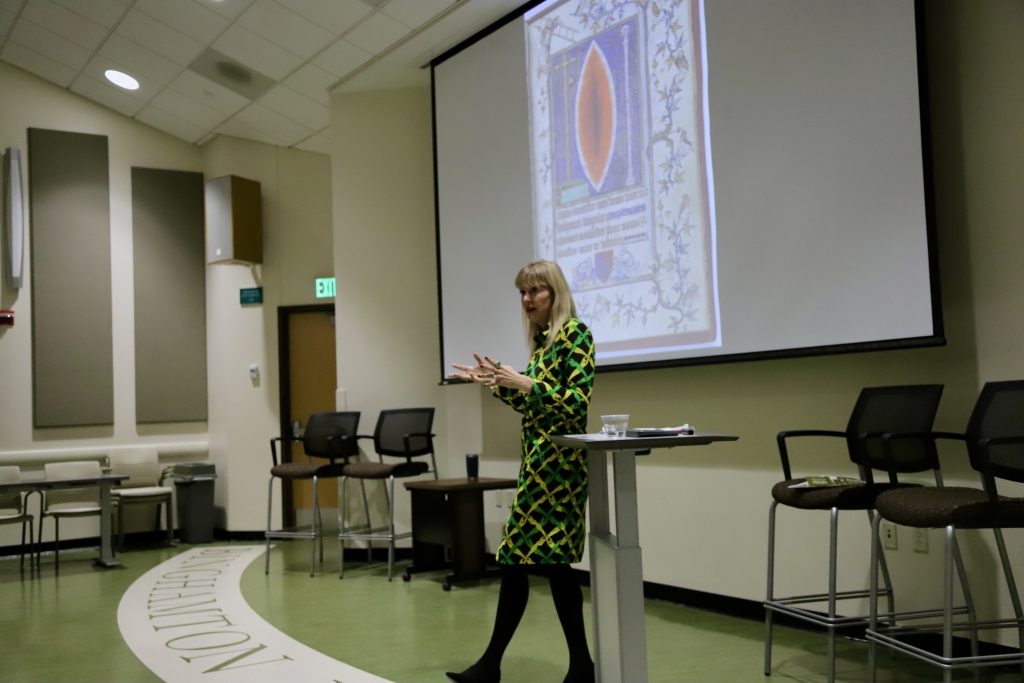This past week marked the 33rd installment in Binghamton University’s annual CEMERS Bernardo Lecture Series. Held last Thursday in the Admissions Center, the event honors Professor Aldo Bernardo, distinguished service professor of Italian and comparative literature. The CEMERS Bernardo lectures are dedicated to Bernardo’s fields of interest, with a focus on medieval and Renaissance history. This year’s lecture was given by Tulane Professor of Art History Holly Flora, entitled “Beyond the Book of Hours: Female Lay Readers and the Wounds of Saint Francis.”
Upon arriving, attendees were immediately greeted by a catered meal complete with charcuterie, turkey meatballs and a small wine bar by the center desk. The first hour of the event acted as a short reception, encouraging the attendees to interact with one another and engage in academic conversation before the lecture began.
Deborah Howell, assistant dean of academic affairs at the Thomas J. Watson College of Engineering and Applied Science, gave her thoughts on the draw of the Bernardo lecture series toward the campus community.
“I think an event like this can draw in people from a lot of different places on the campus that are interested in the topic that might not have anything to do with medieval and renaissance studies,” Howell said. “I work in engineering. I’m an engineer myself, but because of the topic of the lecture — that’s why I’m here. I think lectures like this are great.”
Ann O’Connor, a sophomore majoring in psychology, introduced her own idea as to why people may decide to attend.
“I think that it enhances the overall student experience because it introduces students to something they haven’t learned about before,” O’Connor said. “You get to learn about certain cultures, like in [the medieval] time period. I think it’s very informative and a good experience to hear from professionals.”
The topic of this lecture, particularly its focus on female lay readers in the medieval time period, seemed to have drawn in many of the attendees present.
Colin Hannifan, an undeclared freshman, discussed how lectures like this one are useful opportunities to connect with people who share similar interests.
“It’s a good place to meet people,” Hannifan said. “You can bond over the speakers you like to hear. I went to a lecture yesterday for one of my other courses, and it was just a super good bonding experience for all the students.”
Hannifan cited other reasons why he appreciates events like this one.
“It’s good for students who are struggling in specific classes,” Hannifan said. “It’s something to do and something to learn from.”
Howell explained why she felt an interest in this topic specifically.
“I’m interested in Saint Francis, and I am a reader at church,” Howell said. “When they said female lay readers I thought, I wonder what this has to do with Saint Francis.”
After the hour-long reception, attendees were treated to Flora’s research on an Italian manuscript, MS 411 at the Biblioteca Nazionale Vittorio Emanuele II in Rome. The manuscript depicted the relationship between a female reader and her genuflection toward Saint Francis, wherein Flora examines the emphasis of Saint Francis’ side wound as a ‘focal point’ for the female reader.
The consistent depiction of the woman in MS 411 as a woman of worship and of impressive proximity to the subject of her prayers, Francis, suggested some unexpected details about the potential history of the document. When analyzing the imagery through a feminist lens, it’s unusual and surprising to witness a female lay reader being depicted so physically close to Francis, asserting that the woman in the images may be of some religiously influential origin.
Flora raised some questions about MS 411 and its origins. She emphasized the interesting capability of the document in subverting certain expectations placed on manuscripts of its like. The absence of identifying heraldry, the appropriation of Christ’s wounds and the unprecedented access to Saint Francis all contributed to a curious mystery about MS 411. Did the woman’s importance prompt the creation of the manuscript? The answers to these questions may be lost to the tides of time.
Flora closed out the lecture with some of her favorite words from Saint Francis himself.
“A perfect life can be lived anywhere,” Flora said. “Poverty is everywhere, charity is everywhere.”



